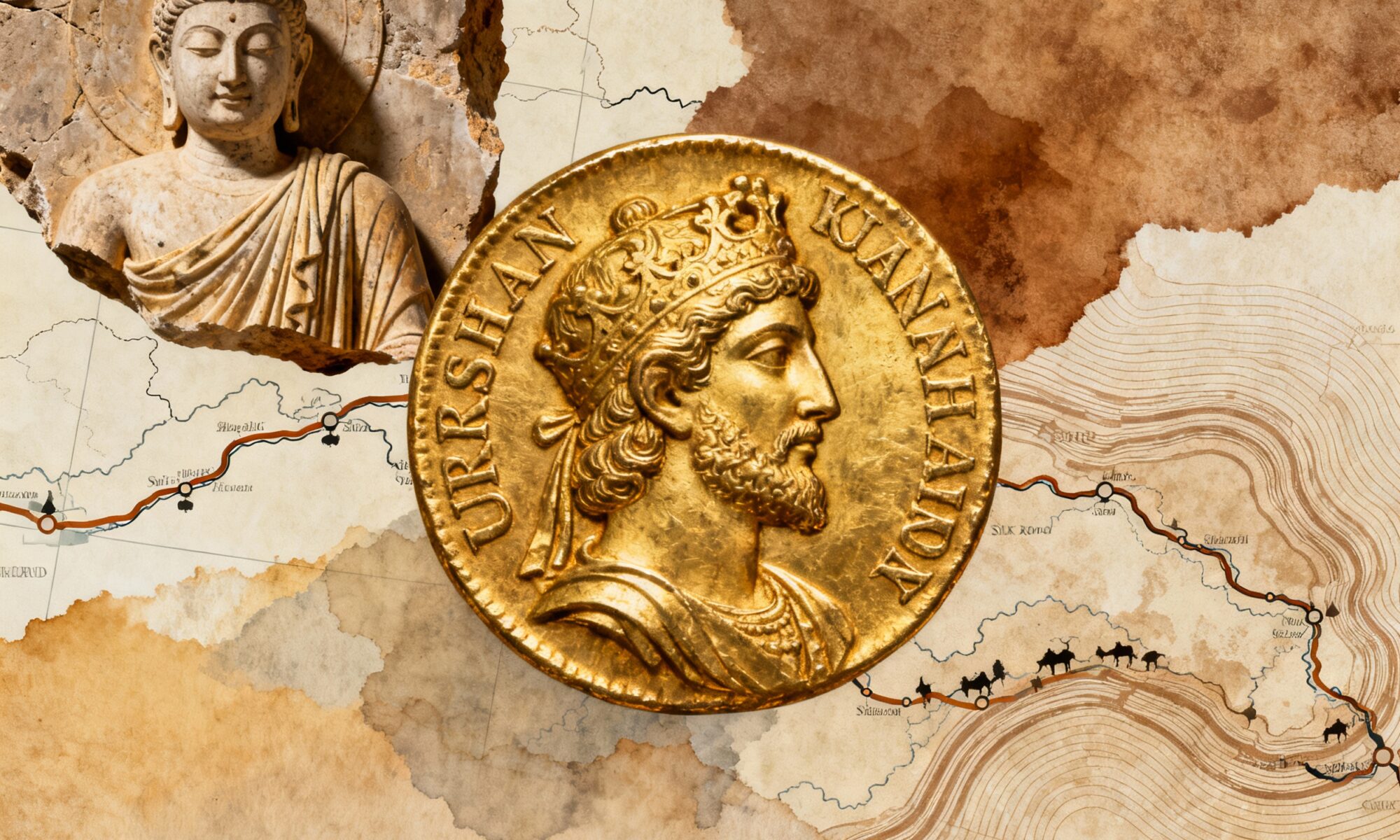From Nomadic Warriors to Empire Builders
The story of the Kushans begins not in a grand capital, but on the windswept steppes of Central Asia. Their ancestors were a people known to the Chinese as the Yuezhi, a confederation of nomadic tribes living in the Tarim Basin (modern-day Xinjiang). In the 2nd century BCE, they were driven from their homeland by the fierce Xiongnu, the same people who prompted China to build its Great Wall.
This forced migration sent the Yuezhi westward, eventually leading them into the region of Bactria (parts of modern Afghanistan, Tajikistan, and Uzbekistan). This land was not empty; it was the heart of the Greco-Bactrian Kingdom, a state founded by the successors of Alexander the Great. Here, the Yuezhi encountered and eventually absorbed the Hellenistic culture that had flourished for centuries.
Around the 1st century CE, a dynamic leader from one of the five Yuezhi tribes, a man named Kujula Kadphises, united his people. He led them to conquer the remaining Greco-Bactrian territories and pushed south into what is now Pakistan and Northern India. He was the founder of the Kushan Empire, a state that would soon stretch from Central Asia to the Ganges river valley, becoming one of the four great Eurasian powers of its time, alongside Rome, Persia (Parthia), and China.
The Golden Hub of the Silk Road
If the Silk Road was the circulatory system of the ancient world, the Kushan Empire was its heart. Its strategic location gave it a near-monopoly on the overland trade routes connecting East and West. Caravans laden with Chinese silk had to pass through Kushan territory to reach Persian and Roman markets. In the opposite direction flowed:
- Roman gold, glassware, and wine
- Indian spices, cotton textiles, and ivory
- Central Asian horses, so prized by Chinese emperors
- Exotic goods from across the known world
The Kushans were not merely passive toll collectors. They actively protected the trade routes, built caravanserais (roadside inns), and managed this incredible flow of wealth. Most importantly, they created a stable and internationally recognized currency. Kushan emperors minted beautiful gold coins, adhering to the Roman weight standard, which made them readily acceptable from the bazaars of Alexandria to the markets of Luoyang. A Roman merchant could use a Kushan dinar as easily as a local one, a testament to the empire’s economic clout and integration into the global economy.
A Melting Pot of Gods and Art: The Birth of Greco-Buddhism
Nowhere is the Kushan role as a cultural crossroads more visible than in their art and religion. When the Kushans settled in Bactria and Gandhara (a region in modern-day Pakistan and Afghanistan), they inherited a rich Hellenistic artistic tradition. As Buddhism spread northward from India, these two powerful forces merged, creating one of history’s most striking examples of cultural syncretism: Greco-Buddhist art.
For the first time, the Buddha was depicted in human form on a massive scale. But this was a Buddha like no other. In the workshops of Gandhara, sculptors carved images of the Buddha with the facial features of a Greek god, wavy hair tied in a topknot reminiscent of Apollo, and draped in a heavy, toga-like robe (the samghati) with realistic, classical folds. In some reliefs, the Buddha is even protected by a muscular, club-wielding figure who is unmistakably the Greek hero Herakles, reinterpreted as the Buddhist protector deity Vajrapani.
This religious tolerance was official policy. Kushan coins are a pantheon in miniature, featuring deities from a staggering range of cultures. You can find Greek gods like Helios, Iranian figures like the fire god Atar, Hindu deities like Shiva, and of course, the Buddha. The Kushans didn’t just tolerate different faiths; they embraced them, creating a uniquely pluralistic society.
King Kanishka the Great: Patron of a New Buddhism
The Kushan Empire reached its zenith under its most celebrated ruler, Kanishka the Great (c. 127–150 CE). A formidable military commander and a savvy administrator, Kanishka is best remembered as a great patron of Buddhism, often compared to the Mauryan emperor Ashoka.
Kanishka’s reign was instrumental in the development and spread of Mahayana Buddhism. This new school of thought presented a more universal path to enlightenment, with a pantheon of compassionate bodhisattvas who delayed their own nirvana to help humanity. Kanishka convened the Fourth Buddhist Council in Kashmir, a monumental gathering of monks and scholars. This council worked to codify the Mahayana doctrines and commentaries, transitioning them from a purely oral tradition to written texts.
This act had profound consequences.有了标准化的经文,大乘佛教更容易传播。正是在库山帝国治下,佛教大规模地沿着丝绸之路向东传播,最终到达中国、韩国和日本,永远地改变了东亚的文化和精神面貌。
The Fading Empire and Its Enduring Legacy
By the 3rd century CE, the Kushan Empire began to decline. It was squeezed by the rise of the aggressive Sassanian Empire in Persia, which chipped away at its western territories. Internal strife and the fragmentation of its vast domain further weakened it, and it slowly faded from the world stage.
So why is this great empire so often forgotten? It was overshadowed by its more famous neighbors in Western and Eastern histories. Its heartland in Afghanistan and Pakistan has faced centuries of instability, making archaeology challenging. Our knowledge today is painstakingly pieced together from Chinese court chronicles, scattered Roman accounts, Kushan inscriptions written in the Bactrian language with the Greek alphabet, and the thousands of coins they left behind.
Yet, to forget the Kushans is to misunderstand the ancient world. They were not just a bridge between civilizations; they were a destination in their own right. They fostered one of the first truly globalized economies, created a stunningly unique artistic tradition, and played a pivotal role in transforming Buddhism into a world religion. The Kingdom of Kushan stands as a powerful testament to the fact that history is not just made at the centers of power, but also at the crossroads where people, goods, and ideas meet and mingle.
